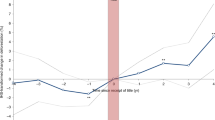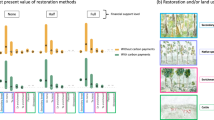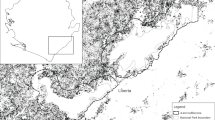Abstract
The Cancún Agreements provide strong backing for a REDD+ (Reducing Emissions from Deforestation and Forest Degradation) mechanism whereby developed countries pay developing ones for forest conservation1. REDD+ has potential to simultaneously deliver cost-effective climate change mitigation and human development2,3,4,5. However, most REDD+ analysis has used coarse-scale data, overlooked important opportunity costs to tropical forest users4,5 and failed to consider how to best invest funds to limit leakage, that is, merely displacing deforestation6. Here we examine these issues for Tanzania, a REDD+ country, by comparing district-scale carbon losses from deforestation with the opportunity costs of carbon conservation. Opportunity costs are estimated as rents from both agriculture and charcoal production (the most important proximate causes of regional forest conversion7,8,9). As an alternative we also calculate the implementation costs of alleviating the demand for forest conversion—thereby addressing the problem of leakage—by raising agricultural yields on existing cropland and increasing charcoal fuel-use efficiency. The implementation costs exceed the opportunity costs of carbon conservation (medians of US$6.50 versus US$3.90 per Mg CO2), so effective REDD+ policies may cost more than simpler estimates suggest. However, even if agricultural yields are doubled, implementation is possible at the competitive price of ∼US$12 per Mg CO2.
This is a preview of subscription content, access via your institution
Access options
Subscribe to this journal
Receive 12 print issues and online access
$209.00 per year
only $17.42 per issue
Buy this article
- Purchase on Springer Link
- Instant access to full article PDF
Prices may be subject to local taxes which are calculated during checkout



Similar content being viewed by others
Change history
31 May 2011
In the abstract of the version of this Letter previously published, the third sentence from the end should have referred to '...alleviating the demand for forest conversion...'. This has now been corrected in the HTML and PDF versions of this Letter.
References
UNFCCC Draft Decision -/CP.16 (United Nations Framework Convention on Climate Change, 2010).
Miles, L. & Kapos, V. Reducing greenhouse gas emissions from deforestation and forest degradation: Global land-use implications. Science 320, 1454–1455 (2008).
Campbell, B. M. Beyond Copenhagen: REDD+, agriculture, adaptation strategies and poverty. Glob. Environ. Change 19, 397–399 (2009).
Strassburg, B., Turner, R. K., Fisher, B., Schaeffer, R. & Lovett, A. Reducing emissions from deforestation—the ‘combined incentives’ mechanism and empirical simulations. Glob. Environ. Change 19, 265–278 (2009).
Kindermann, G. et al. Global cost estimates of reducing carbon emissions through avoided deforestation. Proc. Natl Acad. Sci. USA 105, 10302–10307 (2008).
Phelps, J., Webb, E. L. & Agrawal, A. Does REDD+ threaten to recentralize forest governance? Science 328, 312–313 (2010).
Geist, H. J. & Lambin, E. F. Proximate causes and underlying driving forces of tropical deforestation. Bioscience 52, 143–150 (2002).
Rindfuss, R. R. et al. Frontier land use change: Synthesis, challenges, and next steps. Annu. Assoc. Am. Geograph. 97, 739–754 (2007).
Fisher, B. African exception to drivers of deforestation. Nature Geosci. 3, 375–376 (2010).
Alcamo, J. et al. Millennium Ecosystem Assessment: Scenarios Assessment (Island Press, 2005).
Lewis, S. L. et al. Increasing carbon storage in intact African tropical forests. Nature 457, 1003–1006 (2009).
Ahrends, A. et al. Predictable waves of sequential forest degradation and biodiversity loss spreading from an African city. Proc. Natl Acad. Sci. USA 107, 14556–14561 (2010).
National Sample Census of Agriculture 2002–2003. (National Bureau of Statistics, Ministry of Agriculture and Food Security, Ministry of Water and Livestock Development, Ministry of Cooperatives and Marketing, Presidents Office, Regional Administration and Local Government, Ministry of Finance and Economic Affairs, Dar es Salaam, Tanzania, 2007).
Mwampamba, T. H. Has the woodfuel crisis returned? Urban charcoal consumption in Tanzania and its implications to present and future forest availability. Energ. Policy 35, 4221–4234 (2007).
Hyden, G. Governance and poverty reduction in Africa. Proc. Natl Acad. Sci. USA 104, 16751–16756 (2007).
Rockstrom, J. et al. Conservation farming strategies in East and Southern Africa: Yields and rain water productivity from on-farm action research. Soil. Till. Res. 103, 23–32 (2009).
Sanchez, P. et al. The African Millennium Villages. Proc. Natl Acad. Sci. USA 104, 16775–16780 (2007).
Sanchez, P. A. Tripling crop yields in tropical Africa. Nature Geosci. 3, 299–300 (2010).
Ewers, R. M., Scharlemann, J. P. W., Balmford, A. & Green, R. E. Do increases in agricultural yield spare land for nature? Glob. Change Biol. 15, 1716–1726 (2009).
Rudel, T. K. et al. Agricultural intensification and changes in cultivated areas, 1970–2005. Proc. Natl Acad. Sci. USA 106, 20675–20680 (2009).
Angelsen, A. & Kaimowitz, D. Rethinking the causes of deforestation: Lessons from economic models. World Bank Res. Obser. 14, 73–98 (1999).
Bailis, R., Ezzati, M. & Kammen, D. Mortality and greenhouse gas impacts of biomass and petroleum energy futures in Africa. Science 308, 98–103 (2005).
Kammen, D. M. Cookstoves for the developing world. Sci. Am. 273, 72–75 (1995).
Zein-Elabdin, E.O. Improved stoves in Sub-Saharan Africa: The case of the Sudan. Energ. Econom. 19, 465–475 (1997).
DeFries, R. & Rosenzweig, C. Toward a whole-landscape approach for sustainable land use in the tropics. Proc. Natl Acad. Sci. USA 107, 19627–19632 (2010).
West, P.C. et al. Trading carbon for food: Global comparison of carbon stocks vs. crop yields on agricultural land. Proc. Natl Acad. Sci. USA 107, 19645–19648 (2010).
Palm, C. A. et al. Identifying potential synergies and trade-offs for meeting food security and climate change objectives in sub-Saharan Africa. Proc. Natl Acad. Sci. USA 107, 19661–19666 (2010).
Ferraro, P. J. & Pattanayak, S. K. Money for nothing? A call for empirical evaluation of biodiversity conservation investments. PLoS Biol. 4, 482–488 (2006).
Danielsen, F. et al. At the heart of REDD+: a role for local people in monitoring forests? Conserv. Lett. 4, 158–167 (2011).
Acknowledgements
Funding was provided by The Leverhulme Trust (UK) under the ‘Valuing the Arc’ programme. B.F. was partially funded by a Program in Science, Technology and Environmental Policy (STEP) fellowship at Princeton University. We thank L. Estes, K. Kulindwa, B. Mbilinyi, S. Mwakalila, S. Morse-Jones, R. Naidoo, N. Olwero, B. Phalan, T. Ricketts, P. Sanchez, B. Strassburg and D. Wilcove for helpful discussions and comments.
Author information
Authors and Affiliations
Contributions
B.F. and A.B. conceived the study. B.F., A.B., S.L.L., N.D.B. and R.K.T. designed the study. B.F., S.L.L., R.E.M., P.K.M. and S.W. collected data. B.F., A.B., S.L.L., R.D.S., R.E.M., P.K.M. and S.W. analysed the data. B.F., A.B. and S.L.L. wrote the paper.
Corresponding author
Ethics declarations
Competing interests
The authors declare no competing financial interests.
Supplementary information
Supplementary Information
Supplementary Information (PDF 1792 kb)
Rights and permissions
About this article
Cite this article
Fisher, B., Lewis, S., Burgess, N. et al. Implementation and opportunity costs of reducing deforestation and forest degradation in Tanzania. Nature Clim Change 1, 161–164 (2011). https://doi.org/10.1038/nclimate1119
Received:
Accepted:
Published:
Issue Date:
DOI: https://doi.org/10.1038/nclimate1119
This article is cited by
-
Inequitable Gains and Losses from Conservation in a Global Biodiversity Hotspot
Environmental and Resource Economics (2023)
-
Determinants of Cookstoves and Fuel Choice Among Rural Households in India
EcoHealth (2019)
-
Global variation in the cost of increasing ecosystem carbon
Nature Climate Change (2018)
-
Beyond opportunity costs: who bears the implementation costs of reducing emissions from deforestation and degradation?
Mitigation and Adaptation Strategies for Global Change (2018)
-
Lost benefits and carbon uptake by protection of Indian plantations
Mitigation and Adaptation Strategies for Global Change (2018)



